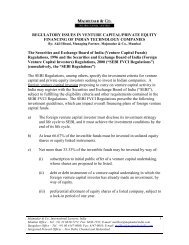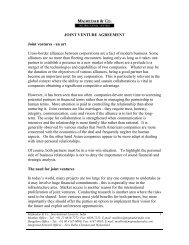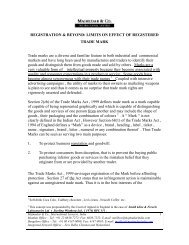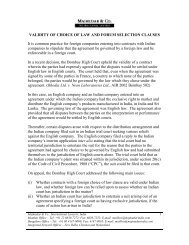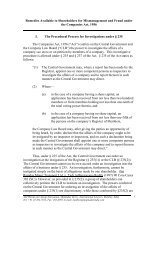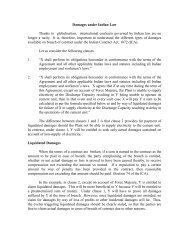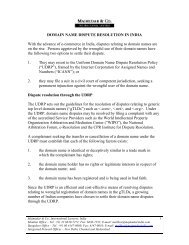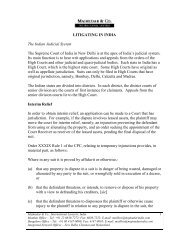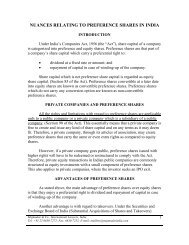Fundamentals of joint venture agreement.pdf
Fundamentals of joint venture agreement.pdf
Fundamentals of joint venture agreement.pdf
You also want an ePaper? Increase the reach of your titles
YUMPU automatically turns print PDFs into web optimized ePapers that Google loves.
JOINT VENTURE AGREEMENT1.0 JOINT VENTURES - AN ARTCross-border alliances between corporations are a fact <strong>of</strong>modern business. Some alliances are no more than fleeting encounterslasting only as long as it takes one partner to establish a presence in anew market while others are a prelude to a merger <strong>of</strong> the technologiesand capabilities <strong>of</strong> two companies. Whatever may be the duration orthe objectives <strong>of</strong> various alliances, being a good partner has becomean important asset for any corporation. This is particularly relevant inthe global context where the ability to create and sustaincollaborations is vital in companies obtaining a significantcompetitive advantage.However, it has been seen that too <strong>of</strong>ten companies devotemore time to screening potential partners in financial terms rather thanin managing the partnership in human terms. More attention is paid tocontrolling the relationship than about nurturing it. Joint <strong>venture</strong>s arelike marriages - they require trust, honesty, integrity, communication,care and vision if the alliance is to last for the long-term. The scopefor collaboration is strengthened when communication is intensiveand the relationship is more family-like rather than rational. It isgenerally observed by various studies that North American companiesare more concerned with the economics <strong>of</strong> the deal and frequentlyneglect the human aspects. On the other hand Asian companiesappear to be more adept at dealing with inter-personal relationships.Of course, both partners must be in a win-win situation. To highlightthe personal side <strong>of</strong> business relationships is not to deny theimportance <strong>of</strong> sound financial and strategic analysis.2.0 THE NEED FOR JOINT VENTURESIn today’s world, many projects are too large for any onecompany to undertake as it may involve huge financial commitments -this is especially true in the infrastructure area. Market access isanother reason for the international proliferation <strong>of</strong> <strong>joint</strong> <strong>venture</strong>s.Conducting research is another area where the risks need to be shared.Joint <strong>venture</strong>s must yield benefits for both partners, but more
importantly they should <strong>of</strong>fer the parties an option to implement theirvision for the future and exploit unforeseen opportunities.Alliances are <strong>of</strong> special relevance in emerging markets such asIndia, as these markets come out <strong>of</strong> their self-imposed isolation andinsulation from external world markets and move towards a relativelyopen and competitive business environment. Indian-owned businessesin recent years have realized their inadequacies in terms <strong>of</strong> products,technology, infrastructure and even management processes. On theother hand, several multinational companies find themselves illequipped to latch on to market opportunities due to lack <strong>of</strong> localknowledge and inadequate distribution network. Alliances betweenthose possessing different skills and strengths in technology,marketing and distribution, etc. have become not only desirable butnecessary.While the process <strong>of</strong> forming these alliances calls for skillednegotiators and planners, the challenge lies in managing and makingthe alliance work. It is <strong>of</strong> critical importance that the pr<strong>of</strong>essionaldrafter <strong>of</strong> the <strong>agreement</strong>s must be involved not only at thenegotiations stage but also at the stage when the business plans arediscussed between the two potential partners.3.0 NATURE OF A JOINT VENTUREJoint <strong>venture</strong>s may be either contractual or structural, or both.They may be broad based or narrowly defined. Long-term <strong>joint</strong><strong>venture</strong>s, particularly broad based are best suited for a corporatestructure. Corporate <strong>joint</strong> <strong>venture</strong>s are characterized by sharedownership and <strong>of</strong>ten shared functions such as research anddevelopment, manufacture, assembly or marketing. Shared ownershipleads to shared governance and shared dependency.The success <strong>of</strong> <strong>joint</strong> <strong>venture</strong>s is built on:∗ a common strategic vision shared by the parties;∗ a strong commitment to each other and to the <strong>joint</strong> <strong>venture</strong>; and
∗ providing business contributions by the parties that arecomplementary.4.0 THE STAGES OF ESTABLISHING A JOINT VENTURE4.1 Selection <strong>of</strong> partnerUpon identifying a business opportunity it is most essential toselect an appropriate partner and open up a dialogue to explore mutualinterest without any firm commitment. The selection process <strong>of</strong>partners can be based on some <strong>of</strong> the following characteristics:∗ long term commitment to the industry, country and <strong>venture</strong>;∗ the value added by the parties should be complementary. Forexample, the local partner may have knowledge <strong>of</strong> the localmarket, business contacts, distribution network, whereas theoverseas partner may have the technical expertise, product range,trade marks, capital and management techniques. Each partnermay be given appropriate recognition for the strength and facilitiesthey bring to the alliance;∗ experience in own area <strong>of</strong> expertise;∗ adequate financial strength;∗ strong local market presence.It may be reiterated that selection <strong>of</strong> an appropriate <strong>joint</strong><strong>venture</strong> partner is most important as a wrong selection can otherwisebreak up the <strong>joint</strong> <strong>venture</strong>.
4.2 The Negotiation PhaseAt this point, the partners should focus not only on the details<strong>of</strong> the type <strong>of</strong> <strong>joint</strong> <strong>venture</strong> but also on the potential problems in theparties’ future relationship. Some <strong>of</strong> the issues are listed below:∗ Agreement over business plans;∗ Probe into the inadequacies and weaknesses <strong>of</strong> each partner;∗ Adequate documentation - confidentiality <strong>agreement</strong>, technologytransfer, technology licensing, patent or trade mark licensing,supply <strong>of</strong> machinery etc.;∗ Clear understanding as to what each partner can do, and cannot do,to avoid any misunderstanding later on;∗ The extent <strong>of</strong> ownership <strong>of</strong> each party in the <strong>joint</strong> <strong>venture</strong>;∗ To define the agreed dividend policy;∗ Building <strong>of</strong> consensus on key problems;∗ Setting exit barriers for each partner through mutual interdependence;∗ Methods <strong>of</strong> valuing the business and settling the partner’s dues incase one <strong>of</strong> the partners wishes to pull out <strong>of</strong> the alliance at a laterstage.4.3 The execution phaseThis involves putting up the project within the shortest timeperiod. This needs a great deal <strong>of</strong> team spirit amongst personnel fromall the partners. The technical information actually starts flowing atthis stage. Disputes may arise on equipment pricing, on quality <strong>of</strong>assigned staff, technological changes or adaptations found necessary
in actual practice, etc. People involved in the tie-up phase shouldstep in and settle the issues quickly and fairly.4.4 The operation phaseThis is the time <strong>of</strong> realization. Market projections may notmaterialize, product cost overruns may occur, process efficienciesmay not be at projected levels and generally performance may lagbehind expectations. This calls for a high level <strong>of</strong> maturity at thesenior most levels. Much needed visionary perspectives should bebrought about to bring solutions.4.5 The maturity phaseAlthough many alliances are open ended when they are set up,very few can ever be perennial and for all time. A key initiative forsustained and continued alliance is to update and modify the alliancecontents and take note <strong>of</strong> changing market requirements.5.0 DOCUMENTATION5.1 The most important document is a Joint Venture (JV)<strong>agreement</strong> or a Shareholders (SH) <strong>agreement</strong>. Essentially a JV or SH<strong>agreement</strong> provides for the method <strong>of</strong> formation <strong>of</strong> the JV companyand sets out the mutual rights and obligations <strong>of</strong> parties for thepurposes <strong>of</strong> conducting the JV and the manner in which the partieswill conduct themselves in operating and managing the JV company.The JV <strong>agreement</strong> is between partners and does not bind the companyunless it is included in the Articles <strong>of</strong> Association. This has been wellestablished by the Supreme Court decision in the leading case <strong>of</strong> V.B.Rangaraj vs. V.B. Gopalkrishnan and Others 73 Comp Cas 201 (SC)(1992).5.2 An illustrative list <strong>of</strong> major clauses usually incorporated in a JV<strong>agreement</strong> are briefly discussed below:
(a)Parties to JV <strong>agreement</strong>The overseas company that is the original party (MNC or acompany with well established brand names) may not be theactual investor in the Joint Venture. In order to bind theoriginal overseas company (which may be the parent companyor holding company or a sister concern <strong>of</strong> the investingcompany) to the <strong>agreement</strong>, it should be made a party to the JV<strong>agreement</strong> in addition to the investing parties.(b)Business objects and products <strong>of</strong> the <strong>joint</strong> <strong>venture</strong>This clause is probably one <strong>of</strong> the most important clauses <strong>of</strong> theentire <strong>agreement</strong> as it spells out the business to be carried on inall its breadth and depth as well as the territory in which it isproposed to be carried on. A very narrow definition may allowone party to enter into a backward or forward integrated projecton its own. For example, the clause may state that the business<strong>of</strong> the JV company shall be the “manufacture <strong>of</strong> milkchocolates”. However, in later years one party may start on itsown the manufacture <strong>of</strong> confectioneries that are not milkchocolates after having gained experience <strong>of</strong> the Indiandistribution system. This may never have been the intention <strong>of</strong>the other party. Thus, the language <strong>of</strong> this clause must beprecise and accurate. The technical details <strong>of</strong> the product to bemanufactured may also be defined. It may also provide forexpansion in the range <strong>of</strong> business in future.(c)Formation <strong>of</strong> JV CompanyThis clause lays down the method <strong>of</strong> formation <strong>of</strong> the JVcompany by registering a new company under the CompaniesAct or by converting an existing company into a JV company.It also spells out the details as to which party is responsible forthe formation <strong>of</strong> the company and obtaining the regulatoryapprovals for the proposed <strong>venture</strong> including the method ormanner <strong>of</strong> sharing these costs and obligations.
(d)Registered <strong>of</strong>ficeThis clause states the location <strong>of</strong> the JV business and theregistered <strong>of</strong>fice <strong>of</strong> the company, both <strong>of</strong> which may be at thesame place, or at different places. The availability <strong>of</strong> specialincentives and facilities may depend on the location <strong>of</strong> theoperations.(e)Equity participation by local and foreign investorsThe extent <strong>of</strong> shareholding <strong>of</strong> each <strong>of</strong> the local and foreignInvestors is defined in this clause and the consideration to bebrought in by each <strong>of</strong> them is spelt out. The share capital maybe allotted in an agreed ratio by injecting cash or by bringing ininfrastructure facilities, services and assets such as land,building, technology, patents, trademarks, distribution network,goodwill, plant and machinery, etc.(f)Finance arrangementsThis clause refers to the business plan and the manner <strong>of</strong> raisingthe finance as stated therein. It also provides whether any <strong>of</strong>the parties is required to give guarantees for raising the finance.Further, it provides for the role each party should play in raisingfinance in the stage <strong>of</strong> expansion <strong>of</strong> the JV as mutually agreedby the parties.(g)Specific obligationsThis clause details the specific obligations each partyundertakes to fulfill for the running <strong>of</strong> the JV company, forexample,∗∗∗grant <strong>of</strong> technical assistance and know-how;grant <strong>of</strong> license to use trademark, patent, copyright, etc.;providing the facility <strong>of</strong> established distribution channels;
∗ access to research, innovation, and productimprovements;∗∗providing marketing expertiese;providing management services.Separate <strong>agreement</strong>s may be entered into between the respectiveparties and the JV company for some <strong>of</strong> the above obligations.(h)Agreement as to future issue <strong>of</strong> capitalThis clause sets out the ratios and terms upon which the partieswould subscribe to further issue <strong>of</strong> share capital and theconsideration that they would pay. This should also provide fora situation where one <strong>of</strong> the parties is unable to bring in morefunds due to a variety <strong>of</strong> reasons including a situation where theJV company is making losses requiring continuing financialstrain on the resources <strong>of</strong> the partners in order for the JV tobecome successful.(i)Appointment <strong>of</strong> directorsThis clause sets out the initial composition <strong>of</strong> the Board <strong>of</strong>Directors, representation on the Board <strong>of</strong> each <strong>of</strong> the parties, themanner in which the directors are appointed to the Board,whether the directors are liable for retirement by rotation, thecomposition <strong>of</strong> the Board in the event <strong>of</strong> change in the pattern<strong>of</strong> shareholding, provisions for alternate directors, naming <strong>of</strong>the managing director and the Chairman, remuneration, etc. Itis not always necessary that the Managing Director isrepresentative <strong>of</strong> the majority partner. JVs are based on abalance <strong>of</strong> power rather than on the dominance by any onepartner. It also states whether the Chairman has a casting vote.(j)Conduct <strong>of</strong> the affairs <strong>of</strong> the JV CompanyThis clause includes the following:∗ Frequency <strong>of</strong> Board meetings
∗ Notice∗ Agenda∗ Quorum∗ General Meetings∗ Circular Resolutions∗ Accounting∗ Audit∗ Unanimous consent <strong>of</strong> all JV parties for certain decisionsbecome necessary in circumstances where the JV partnersdo not have equal ownership and control (please referEnclosure for illustrative list).(k)Transfer pricing and buy/sell <strong>agreement</strong>sThis clause spells out the transfer pricing policy in cases wherethe JV company buys raw materials, components, parts, semifinished products or intermediaries from the JV partners, orsells finished products in a buy-back arrangement. Theminimum quantity and price may be spelt out.(l)Share transfersA <strong>joint</strong> <strong>venture</strong> is like a marriage - as described above. It isnormally provided that both parties can terminate the JV<strong>agreement</strong> only on occurrence <strong>of</strong> certain events. Consequently,no party shall sell, charge, gift, transfer or otherwise dispose <strong>of</strong>all or part <strong>of</strong> their shares or beneficial rights. In case there is atermination <strong>of</strong> the <strong>agreement</strong>, this clause provides the manner<strong>of</strong> share transfer. In general, the party disposing <strong>of</strong> its shares is
under an obligation to transfer its shares to the other party. Thiseliminates the risk <strong>of</strong> an unacceptable third party such as acompetitor from taking over a substantial interest in the JVcompany to the detriment <strong>of</strong> the JV’s business. In the eventthat the other party refuses to buy the shares, the seller may<strong>of</strong>fer the shares to a third party but not at a price below the one<strong>of</strong>fered to the other party. The method <strong>of</strong> valuation todetermine the price <strong>of</strong> the shares and the valuer’s name/s maybe also mentioned to avoid conflicts at the time <strong>of</strong> sharetransfer.(m)Distribution / Dividend PolicyThe parties may agree upon the pr<strong>of</strong>its distribution pattern andaccumulation <strong>of</strong> pr<strong>of</strong>its so as to build up reserves. Tax aspects<strong>of</strong> all the parties may be one <strong>of</strong> the important considerations indeciding upon a dividend policy.(n)Name/ Brand licensing <strong>agreement</strong>In many cases, the name <strong>of</strong> one <strong>of</strong> the parties or the brand name<strong>of</strong> their product enjoys considerable goodwill and reputation.Such party may agree to permit the use <strong>of</strong> its name or the brandname <strong>of</strong> its product by the JV company. The JV <strong>agreement</strong>would record the terms and conditions <strong>of</strong> such use and theobligations <strong>of</strong> the parties in respect <strong>of</strong> the use <strong>of</strong> the name byproviding for a separate <strong>agreement</strong> “name licensing <strong>agreement</strong>”to be entered into between the JV company (when incorporated)and the party whose name is being used.(o)Research and Development - Improvement and InnovationThis clause provides for the method in which the JV companywill benefit from any research and development and improvementsand innovations carried out by any one <strong>of</strong> the parties to the <strong>agreement</strong>.It also sets out the procedure for giving reverse benefit to the partiesto the <strong>agreement</strong> if the JV company conducts any research or developsany improvement or innovation.
(p)Non-competition provisionsThis clause records the <strong>agreement</strong> between the parties not tocarry on competing business to that <strong>of</strong> the JV company. Inparticular, it may state that :∗∗∗both parties will undertake manufacturing or marketingonly through the JV company and not permit the use <strong>of</strong>know-how to any other person in the defined territoryno other entity owed or controlled by the parties shallcanvass or entice away any employee <strong>of</strong> the JV companyno party shall carry on similar business for an agreedperiod after termination.(q)Confidentiality/ SecrecyThe <strong>agreement</strong> between the parties to maintain secrecy <strong>of</strong>information relating to the technical process, business, knowhowand other business information that is not already in publicdomain is recorded in this clause. The parties may also providethat they will ensure that their employees will also be bound bythis clause. In addition, it may be provided that the obligation<strong>of</strong> confidentiality and secrecy is maintained at all timesnotwithstanding the termination <strong>of</strong> the JV for any reason.(r)Period <strong>of</strong> <strong>agreement</strong>This clause stipulates the period for which the JV <strong>agreement</strong>would remain in force so as to bind the parties together. It giesthe effective date <strong>of</strong> the <strong>agreement</strong> as the starting point. It alsoprovides for renewal <strong>of</strong> the <strong>agreement</strong> after the initial periodand the circumstances and terms and conditions <strong>of</strong> suchrenewal.(s)TerminationThis clause sets out the events and circumstances under whichthe JV <strong>agreement</strong> is terminated. Some <strong>of</strong> the events are:
∗∗∗∗∗Mutual <strong>agreement</strong> <strong>of</strong> the parties, e.g. resulting fromfundamental dis<strong>agreement</strong> or deadlock over a variety <strong>of</strong>issues, including changing the scope <strong>of</strong> JV or an increasein capital contribution;One <strong>of</strong> the parties not holding any shares in the JVcompany;Material breach by one <strong>of</strong> the parties <strong>of</strong> their obligationsunder the <strong>agreement</strong>;Insolvency, bankruptcy or liquidation <strong>of</strong> any one <strong>of</strong> theparties;Change in laws resulting in non-performance <strong>of</strong> the terms<strong>of</strong> the <strong>agreement</strong>.The clause also provides for the obligations <strong>of</strong> each <strong>of</strong> theparties towards each other in the event <strong>of</strong> termination <strong>of</strong> the<strong>agreement</strong>.(t)Force MajeureThis clause provides protection to a party confronted withevents beyond its control which disable any party fromperforming its obligations under the JV <strong>agreement</strong>.(u)Bearing <strong>of</strong> pre-operative expenses / costsThe manner and proportion <strong>of</strong> bearing <strong>of</strong> expenses incurred bythe parties prior to entering into the JV <strong>agreement</strong> are detailedin this clause. It also provides for bearing <strong>of</strong> expenses in casethe JV does not materialize despite entering into an <strong>agreement</strong>.(v)ArbitrationIn the event that the parties are unable to resolve a disputethrough negotiated settlement or through alternative dispute
esolution methods, a provision for arbitration is required as thelast alternative to litigation in Court. An <strong>agreement</strong> to arbitrateprovides for a forum other than a Court <strong>of</strong> Law so that disputesmay be resolved expeditiously. It also provides for the valuesand law <strong>of</strong> arbitration to be applicable as also the method <strong>of</strong>appointing an arbitrator(s) and the competent jurisdiction inwhich the arbitration award is to be entered.(w)Governing lawThis clause stipulates the system <strong>of</strong> law by which the <strong>agreement</strong>is to be incorporated and enforced. In case <strong>of</strong> foreign inwardinvestment, Indian Government requires that the applicable lawshould be the Indian law.(x)AssignmentParties have to agree whether the <strong>agreement</strong> can be assigned totheir successors and nominees.(y)PreconditionThe <strong>agreement</strong> is expressly subject to the approval <strong>of</strong> RBI orFIPB and the terms and conditions stipulated by the Reserve Bank <strong>of</strong>India in their letter <strong>of</strong> approval are to be made part <strong>of</strong> this <strong>agreement</strong>.
(z)SupremacyThis clause provides that in the event <strong>of</strong> any conflict betweenthe provisions <strong>of</strong> the JV <strong>agreement</strong> and the Articles <strong>of</strong>Association <strong>of</strong> the JV company the intention <strong>of</strong> the parties isthat the provisions <strong>of</strong> the JV <strong>agreement</strong> shall prevail. Theparties are required to exercise their voting rights in a mannerthat gives effect to the provisions <strong>of</strong> the JV <strong>agreement</strong> and ifnecessary alter the Articles <strong>of</strong> the JV suitably.




